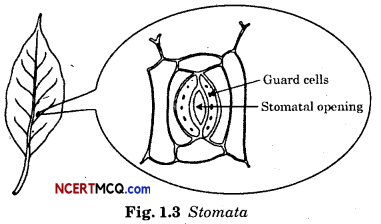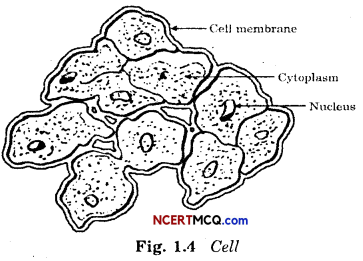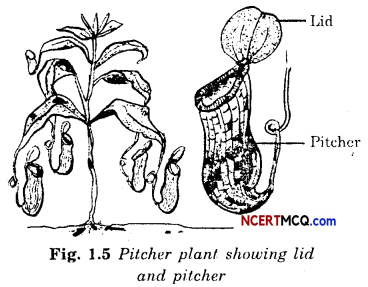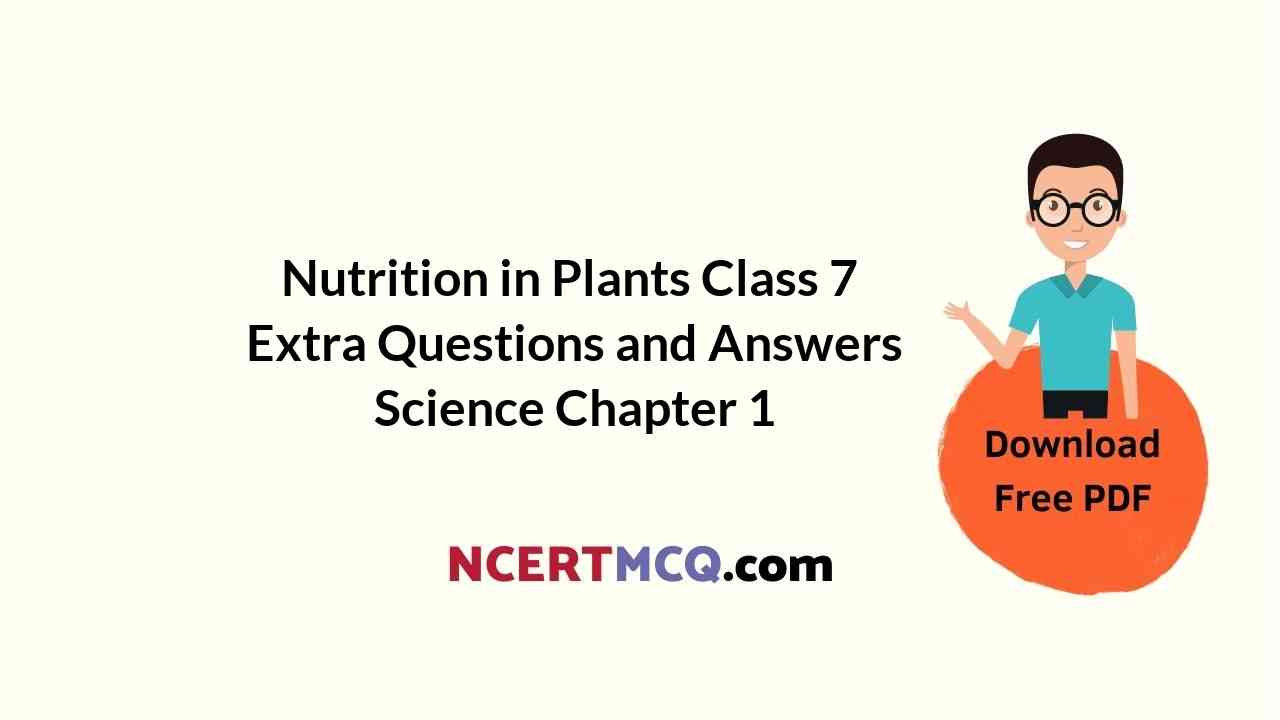Check the below Online Education NCERT MCQ Questions for Nutrition in Plants Class 7 Extra Questions and Answers Science Chapter 1 Pdf free download. https://ncertmcq.com/extra-questions-for-class-7-science/
Online Education for Class 7 Science Chapter 1 Extra Questions and Answers Nutrition in Plants
Nutrition In Plants Class 7 Extra Questions With Answers Question 1.
Name the things necessary for photosynthesis.
Answer:
Carbon dioxide, water, chlorophyll, sunlight.
Class 7 Science Chapter 1 Extra Question Answer Question 2.
Which is the ultimate source of energy?
Answer:
The sun.
Nutrition In Plants For Class 7 Questions With Answers Question 3.
What is the function of chlorophyll?
Answer:
It helps leaves to capture the energy of the sunlight.
Ncert Solutions For Class 7 Science Chapter 1 Extra Questions Question 4.
Is there any organ other than leaves where photosynthesis takes place?
Answer:
Yes. Photosynthesis takes place in all green parts of the plant be it stem or branches, e.g., cactus.\
![]()
Nutrition In Plants Class 7 Questions And Answers Question 5.
What are algae?
Answer:
Algae are microorganisms. They are found as slimy, green patches in ponds or in other stagnant water bodies.
Extra Questions For Class 7 Science Nutrition In Plants Question 6.
Which bacteria can convert nitrogen into soluble form?
Answer:
Rhizobium.
Ncert Class 7 Science Chapter 1 Extra Questions Question 7.
Name two leguminous plants.
Answer:
Pea, gram.
Nutrition In Plants For Class 7 Worksheet With Answers Question 8.
Why are plants called autotrophs?
Answer:
Auto means self and trophies means nourishment. So, autotrophs means organisms that can make nutrients for themselves. Plants are such organisms so, they are called autotrophs.
Class 7 Science Ch 1 Extra Questions Question 9.
What do you mean by heterotrophs?
Answer:
Heteros means other; trophies mean nourishment. So, heterotrophs means organisms that depend on others for their nutrition. Animals including man are such organisms.
Extra Questions On Nutrition In Plants Class 7 Question 10.
How is Sun the ultimate source of energy for all the living beings?
Answer:
Green plants prepare food utilising nigh gall other organisms depend on green plants directly or indirectly for their nutrition. So, Sun is the ultimate source of energy.
![]()
Class 7 Nutrition In Plants Extra Questions Question 11.
How do fungi derive nutrition?
Answer:
Fungi secrete digestive juices on the dead and decaying matter and convert it into a solution. Then they absorb the nutrients from it.
Class 7 Science Chapter 1 Short Question Answer Question 12.
What are stomata? Draw diagram.
Answer:
The small pores present on the surface of the leaves are called stomata. They are surrounded by ‘guard cells’. They help in taking carbon dioxide and releasing during photosynthesis.

Class 7 Chapter 1 Science Extra Questions Question 13.
What do you mean by symbiotic relationship?
Answer:
Some organisms live together and share shelter and nutrients. This is called symbiotic relationship. For example, certain fungi live in the roots of trees. The tree provides nutrients to the fungus and, in return, receives help from it to take up water and nutrients from the soil.
Science Class 7 Chapter 1 Extra Questions Question 14.
What are saprotrophs?
Answer:
The mode of nutrition in which organisms take in nutrients in solution form from dead and decaying matter is called saprotrophic nutrition. Plants which use saprotrophic mode of nutrition are called saprotrophs.
Chapter 1 Science Class 7 Extra Questions Question 15.
What do you know about cell?
Answer:
Just like buildings are made of bricks, the bodies of living organisms are made of tiny units called cells. A cell can be defined as the structural and functional unit of the living organisms. Cells can be seen under the microscope. Some organisms are made of only one cell. The cell is enclosed by a thin outer boundary, called the cell membrane, Most cells have a distinct, centrally located spherical structure called the nucleus. The nucleus is surrounded by a jelly-like substance called cytoplasm.

![]()
Question 16.
If the pitcher plant is green and carries out photosynthesis, then why and how does it feed on insects?
Answer:
The pitcher plant is green and carries out photosynthesis. Thus, it gets its nutrition by this process. But it does not get nitrogen which is required for its growth from the soil in which it grows.

The pitcher plant have pitcher like structures which are the modified parts of the leaves. The apex of the leaf forms a lid which can open and close the mouth of the pitcher. Inside the pitcher are hair which are directed downwards. When an insect lands in the pitcher, the lid closes and the trapped insect gets entangled into the hair. The insect is digested by the* digestive juices secreted in the pitcher.
Question 17.
Boojho wants to know how water and minerals absorbed by roots reach the leaves.
Answer:
Water and minerals are transported to the leaves by the vessels which run like pipes throughout the roots, stems, and leaves of the plant. They form a continuous path or passage for the nutrients to reach from the roots to the leaves.
Question 18.
From where do the plants obtain nitrogen?
Answer:
Soil has certain bacteria that convert gaseous nitrogen into a usable form and release it into the soil. These soluble forms are absorbed by the plants along with water.
Question 19.
There are some plants which do not have chlorophyll. How do they survive and from where do they derive nutrition?
Answer:
They have different mechanisms fir deriving nutrition from other organisms. They are heterotrophs. They take readym&de food from the plant on which it is climbing.
Question 20.
Are we and the other animals also parasites for the plants?
Answer:
No, parasites live on the host and derive nutrition from it. They do not eat any body part of the host. But, man or other animals (like cow) eat plants or plant products. In return, man and the other animals provide CO2 to the plant
for photosynthesis.
Question 21.
Paheli wants to know whether mosquitoes, bed bugs, lice and leeches that suck our blood are also parasites.
Answer:
Lice are parasites because they live on another organisms like human beings and other animals and get their nutrition without benefitting the host. Mosquitoes, bed bugs and leeches though suck blood from other organisms’ body are not parasites as they do not live on the host.
Question 22.
Paheli wants to know how fungi appear suddenly during the rainy seasons.
Answer:
The fungal spores are generally present in. the air. When they land on Wet and warm things they germinate and grow. During rainy season, there are more chances of things getting wet: So, fungi get more favourable conditions for its growth and hence spoil more things in -rainy season.
Question 23.
How would you test the presence of starch in leaves?
Answer:
When iodine comes in contact with starch, a dark blue-black colour appears. By dropping iodine solution on the leaves, we can check the presence of starch.
![]()
Experiments:
(1)
Aim: To show that sunlight is necessary for photosynthesis.
Requirements: Two potted plants, iodine solution and a dropper.
Procedure:
- One potted plant is kept in sunlight for three days.
- The other potted plant is kept in complete darkness.
- After three days, with the help of a dropper, a few drops of iodine solution are dropped Oflone leaf of each of the potted plants.
Observation: Blue-black colour appears on the leaf of plant kept in sunlight while nothing happens in the leaf of plant kept in dark.
Conclusion: Iodine solution turns blue-black when comes in contact with starch. So, the leaf of the plant kept in sunlight turns blue-black but no starch was formed in plant kept in darkness. This proves that sunlight is necessary for photosynthesis.
(2)
Aim: To show that chlorophyll is necessary for photosynthesis.
Requirements: Plant with variegated leaves, iodine solution and a dropper.
Procedure:
- The plant with variegated leaf is kept in sunlight or a few hours.
- Now with the help of a dropper, a few drops of iodine solution is dropped on one leaf so that it drenched out the leaf completely.
Observation: The green part of the leaf turns blue-black but the other coloured part remains as it is.
Conclusion: Photosynthesis occurs in green parts only. So, chlorophyll is necessary for photosynthesis.
Multiple Choice Questions
1. In the activity, one of the two plants is kept in dark, because :
(i) exposure to sunlight can discolour the leaves.
(ii) leaves are to be put on rest for some time.
(iii) no fresh starch can be formed within the leaves and the leaves become starchless.
(iv) iodine does not work if the plant is not kept in the dark.
Answer:
(iii) no fresh starch can be formed within the leaves and the leaves become starchless.
2. In the activity, when a few drops of iodine are put on the leaf of plant that was kept in sunlight, the leaf turns :
(i) green
(ii) yellow
(iii) blue
(iv) blue-black.
Answer:
(iv) blue-black.
3. Iodine test is done to test the presence of:
(i) protein
(ii) fat
(iii) vitamin
(iv) starch.
Answer:
(iv) starch.
![]()
4. A boy collected some slimy, green patches from ponds in a beaker. He observed it with a hand lens. The specimen observed is :
(i) fungi
(ii) algae
(iii) bacteria
(iv) virus.
Answer:
(ii) algae.
5. Algae are green in colour because :
(i) they contain chlorophyll
(ii) they rust due to water
(iii) they bear some green patches
(iv) they absorb green colour from the aquatic plants.
Answer:
(i) they contain chlorophyll.
6. The leaves other than green :
(i) have no chlorophyll
(ii) have chlorophyll
(iii) have red, brown and other pigments but no chlorophyll
(iv) are not leaves but modified flowers.
Answer:
(ii) have chlorophyll.
7. The food synthesised by the plants is stored as :
(i) protein
(ii) fat
(iii) starch
(iv) lignin
Answer:
(iii) starch.
![]()
8. During the process of photo¬synthesis :
(i) hydrogen is released
(ii) oxygen is released
(iii) carbon dioxide is released
(iv) water is released.
Answer:
(ii) oxygen is released.
9. Why do you think the piece of bread was moistened a little?
(i) Because bread needs water to remain fresh.
(ii) Because fungi grow on moist and warm organic matter.
(iii) Because it can become suitable for the growth of algae.
(iv) So that the decaying of the bread can be prevented.
Answer:
(ii) Because fungi grow on moist and warm organic matter.
10. On observing the patches of bread under magnifying glass :
(i) sponge-like structures are seen.
(ii) red coloured thread-like structures are seen.
(iii) green coloured liquid on the surface is seen.
(iv) cotton-like threads spread on the piece of bread are seen.
Answer:
(iv) cotton-like threads spread on the piece of bread are seen.
11. The mode of nutrition in which organisms take in nutrients in solution form from dead and decaying matters is called :
(i) autotrophic mode of nutrition
(ii) biotrophic mode of nutrition
(iii) saprotrophic mode of nutrition
(iv) homotrophic mode of nutrition.
Answer:
(iii) saprotrophic mode of nutrition.
12. Which of the following is a saprotroph?
(i) Cuscuta
(ii) Fungi
(iii) Dhatura
(iv) Algae
Answer:
(ii) Fungi.
keywords:
→ Autotrophs: Organisms that can make their own food are called autotrophs or producers. For example, green plants.
→ Insectivorous plants: Plants that eat insects are called insectivorous plants. For example, pitcher plant.
→ Photosynthesis: The process by which green plants make their food from water and carbon dioxide in presence of sunlight is called photosynthesis.
→ Chlorophyll: It is a green pigment found in plants which helps is photosynthesis.
→ Nutrient: The components of food that are essential for an organisms to survive are called nutrients.
→ Nutrition: Nutrition is the mode of taking food by an organism and its utilisation by the body.
→ Heterotrophs: Organisms that depend on other organisms for their food are called heterotrophs. For example, human beings.
→ Parasite: The organism that derives nutrients from another organism without benefitting it. is called parasite. For example,lice.
→ Host: The organism from which a parasite gets its nutrition is called a host.
→ Saprotrophic nutrition: The mode of nutrition in which organisms take in nutrients in solution form, from dead and decaying matter is called saprotrophic nutrition.
→ Saprotrophs: Plants which use saprotrophic mode of nutrition are called saprotrophs. For example, fungi.
→ Stomata: The tiny pores present on the surface of the leaves surrounded by ‘guard cells’ are called stomata.
